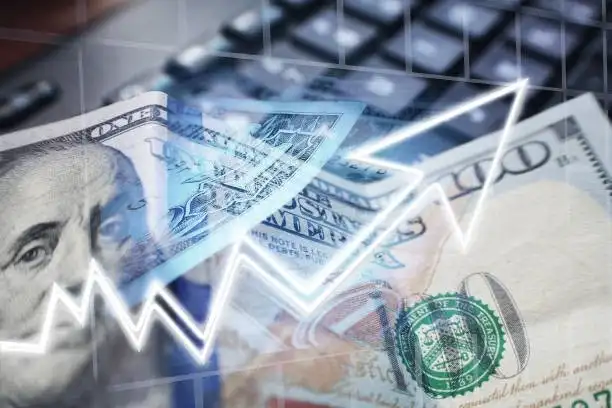The release of soft inflation data has made Wall Street crazy. The S&P 500,, along with the Nasdaq Composite have reached a peak that made the day a banner day in history. This sudden jump was the result of some postive factors which will be discussed here.
Before going into the details of these two factors, let’s give you an overview of what propelled the market to jump. First of all, the market did not anticipate the inflation data to go so much cooler and easier on the investors as the prices were not hiking.
Secondly, investors are increasingly betting on the Federal Reserve enacting interest rate cuts in the near future, further fueling market optimism.
Soft Inflation Data
The positive market sentiment can be largely attributed to a key economic indicator: the Consumer Price Index (CPI). CPI, in common terminology, is called the ‘inflation gauge” by investors. For the beginners we will explain the purpose of this inflation gauge. It tracks or monitors the average amount as price fluctuations that investors or consumers pay for the respective goods and services.
This basket includes essentials like food, housing, transportation, and healthcare, essentially reflecting the typical spending patterns of American households. By monitoring the CPI, economists and investors can gauge how inflation is impacting the overall cost of living.
In the context of this story, the April 2024 CPI report delivered a welcome surprise. The inflation rate came in at 3.4% year-over-year, which crucially matched analyst expectations. This rate may seem like something insignificant to novices but for experienced consumers or traders it means potential for a big change.
For the past few months, inflation readings have consistently exceeded forecasts, raising concerns about a potential inflationary spiral.
The April data, by meeting expectations, suggests a possible stabilization in price increases. This brings a sigh of relief to investors who were worried about persistently high inflation eroding corporate profits and consumer purchasing power.
Interest Rate Cut Speculation
The Fed or the Federal Reserve being the central bank in the US will serve the purpose of maintaining price stability and offering huge employment opportunities for people.
In order to offer such purposes the Fed has to use something against the economy—the interest rates. They play with the interest rates from time to time so that they can control the market with interest borrowing costs within the economy.
Lower inflation data, like the news of April’s 3.4% rate, can significantly impact the Fed’s decision-making on interest rates. When inflation is under control, the pressure to raise rates to cool down the economy eases. The Fed also wants to keep inflation under control, so it will consider keeping the interest rates at an optimum level or even lowering them for the sake of the economy and the market.
The news of softer inflation data has fueled speculation that the Fed will enact a dovish turn, meaning a more accommodative monetary policy.
According to financial instruments like CME Group’s FedWatch Tool, the market now sees a much higher probability (over 70%) of a rate cut happening as early as September 2024.
Furthermore, investors are fully pricing in two rate cuts of 0.25% each by the end of the year. This prospect of lower borrowing costs in the near future is a major reason for the current market optimism.
However, the recent inflation report has undoubtedly opened the door for potential rate cuts in the coming months, a move that is being enthusiastically embraced by investors.
Market Response by Sector
The news of soft inflation wasn’t met with a uniform response across all sectors. Instead, we witnessed a clear distinction in performance based on companies’ sensitivity to interest rates.
Among these companies and sectors, the most affected ones were technology and real estate. Lower interest rates make borrowing cheaper, which translates to increased investment in growth-oriented tech companies.
This optimism fueled a surge in the tech-heavy Nasdaq Composite, with ETFs like the VanEck Semiconductor ETF (SMH) experiencing a 2.2% jump. Similarly, the prospect of lower mortgage rates boosted the real estate sector, with the iShares U.S. Home Construction ETF (ITB) climbing 3.2%.
Beyond these heavyweights, the rally extended to small-cap stocks, a segment typically seen as more domestically focused and responsive to economic conditions. The iShares Russell 2000 ETF (IWM), which tracks smaller companies, gained 1%, reflecting broader market confidence.
However, not all companies shared in the celebratory mood. Meme stocks, which had witnessed a spectacular rise earlier in the week, took a sharp turn downwards. AMC Entertainment Holdings (AMC) and GameStop (GME) plummeted by 23% and 31% respectively.
This reversal can be attributed to several factors, including profit-taking by short-term investors and a return to fundamentals-based investing as the market’s focus shifted toward the broader economic picture.
Other Market Movement
The positive vibes on Wall Street weren’t confined to stocks alone. The news of soft inflation triggered a ripple effect across various asset classes:
Investors often seek refuge in safe-haven assets like gold and silver during periods of economic uncertainty. However, with inflation seemingly under control, the demand for these havens softened slightly. Despite this, gold prices still managed a modest gain of 1.3%, while silver rose by a more significant 3%.
Although the market was going over the moon, the price of crude oil remained unchanged for multiple reasons. This could be due to a balancing act between a potential economic slowdown (which could dampen demand) and ongoing supply constraints.
The cryptocurrency market also reacted positively. Bitcoin, the world’s leading cryptocurrency, experienced a 5.5% surge. This rise could be attributed to several factors, including increased risk appetite among investors and Bitcoin’s potential hedge against inflation, although its long-term correlation with inflation is still being debated.
Trading Bots To Gauge The Markets
What are trading bots for, and how are they contributing to this entire soft inflation data scenario? These automated programs are made to monitor and analyze market data to help traders/investors. They look for the right opportunity on behalf of the trader with their trained algorithms to perform the trade on time.
In a scenario like this, where news significantly impacts the market, bots can react much faster than human investors, potentially capturing short-term gains.
Platforms like Gas Profit can also be programmed to exploit technical trading signals triggered by inflation data and interest rate expectations. This can further contribute to market movements. It’s important to note, however, that trading bots are not foolproof. They can malfunction or be based on flawed algorithms, leading to losses. Moreover, human oversight remains crucial.
Investors should understand the risks involved and set clear parameters for their bots to avoid unintended consequences.
Wrapping Up
Wall Street celebrated Wednesday with record highs for the S&P 500 and Nasdaq as a result of the confluence of positive factors.
Furthermore, the prospect of the Federal Reserve enacting rate cuts in the near future sent a wave of optimism through the market. Different sectors responded based on their interest rate sensitivity, with technology and real estate leading the gains. The positive sentiment extended beyond stocks, with Bitcoin and precious metals experiencing modest increases.



































